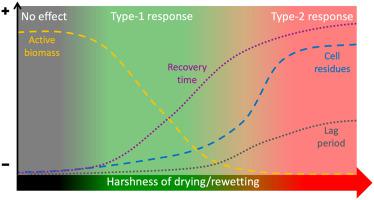Soil Biology and Biochemistry ( IF 9.8 ) Pub Date : 2021-08-24 , DOI: 10.1016/j.soilbio.2021.108400 Albert C. Brangarí 1 , Stefano Manzoni 2, 3 , Johannes Rousk 1

|
Soil moisture is one of the most important factors controlling the activity and diversity of soil microorganisms. Soils exposed to pronounced cycles of drying and rewetting (D/RW) exhibit disconnected patterns in microbial growth and respiration at RW. These patterns differ depending on the preceding soil moisture history, leading to contrasting amounts of carbon retained in the soil as biomass versus that respired as CO2. The mechanisms underlying these microbially-induced dynamics are still unclear. In this work, we used the process-based soil microbial model EcoSMMARTS to offer candidate explanations for: i) how soil moisture can shape the structure of microbial communities, ii) how soil moisture history affects the responses during D/RW, iii) what microbial mechanisms control the shape, intensity and duration of these responses, and iv) what carbon sources sustain the increased biogeochemical rates after RW. We first evaluated the response to D/RW in bacterial communities previously exposed to two different stress histories (‘moderate’ vs ‘severe’ soil moisture regimes). We found that both the history of soil moisture and the harshness of the dry period preceding the rewetting shaped the structure and physiology of microbial communities. The characteristics of these communities determined the harshness experienced and the nature of the responses to RW obtained. Modelled communities exposed to extended severe conditions showed a resilient response to D/RW, whereas those exposed to moderate environments exhibited a more sensitive response. We then interchanged the soil moisture regimes and found that the progressive adaptation of microbial physiology and structure to new environmental conditions resulted in a switch in the response patterns. These microbial changes also determined the contribution of biomass synthesis, osmoregulation, mineralization by cell residues, and disruption of soil aggregates to CO2 emissions.
中文翻译:

支持微生物对干燥和再润湿恢复能力的机制——模型分析
土壤水分是控制土壤微生物活性和多样性的最重要因素之一。暴露于明显的干燥和再润湿循环 (D/RW) 的土壤在 RW 的微生物生长和呼吸方面表现出不连续的模式。这些模式因之前的土壤湿度历史而异,导致土壤中作为生物量保留的碳量与作为 CO 2呼吸的碳量形成对比. 这些微生物诱导的动力学背后的机制尚不清楚。在这项工作中,我们使用基于过程的土壤微生物模型 EcoSMMARTS 为以下内容提供了可能的解释:i) 土壤水分如何塑造微生物群落的结构,ii) 土壤水分历史如何影响 D/RW 期间的响应,iii) 什么微生物机制控制这些反应的形状、强度和持续时间,以及 iv) 哪些碳源在 RW 后维持增加的生物地球化学速率。我们首先评估了先前暴露于两种不同压力历史(“中等”与“严重”土壤水分状况)的细菌群落对 D/RW 的反应。我们发现,土壤水分的历史和再润湿前干旱期的严酷程度都塑造了微生物群落的结构和生理。这些社区的特征决定了所经历的严酷程度以及所获得的对 RW 反应的性质。暴露于长期恶劣条件的模拟社区对 D/RW 表现出弹性反应,而暴露于中等环境的社区则表现出更敏感的反应。然后我们交换了土壤水分状况,发现微生物生理学和结构对新环境条件的逐渐适应导致了响应模式的转变。这些微生物变化还决定了生物量合成、渗透调节、细胞残留物的矿化以及土壤团聚体对 CO2 的破坏作用 暴露于长期恶劣条件的模拟社区对 D/RW 表现出弹性反应,而暴露于中等环境的社区则表现出更敏感的反应。然后我们交换了土壤水分状况,发现微生物生理学和结构对新环境条件的逐渐适应导致了响应模式的转变。这些微生物变化还决定了生物量合成、渗透调节、细胞残留物的矿化以及土壤团聚体对 CO2 的破坏作用 暴露于长期恶劣条件的模拟社区对 D/RW 表现出弹性反应,而暴露于中等环境的社区则表现出更敏感的反应。然后我们交换了土壤水分状况,发现微生物生理学和结构对新环境条件的逐渐适应导致了响应模式的转变。这些微生物变化还决定了生物量合成、渗透调节、细胞残留物的矿化以及土壤团聚体对 CO2 的破坏作用 然后我们交换了土壤水分状况,发现微生物生理学和结构对新环境条件的逐渐适应导致了响应模式的转变。这些微生物变化还决定了生物量合成、渗透调节、细胞残留物的矿化以及土壤团聚体对 CO2 的破坏作用 然后我们交换了土壤水分状况,发现微生物生理学和结构对新环境条件的逐渐适应导致了响应模式的转变。这些微生物变化还决定了生物量合成、渗透调节、细胞残留物的矿化以及土壤团聚体对 CO2 的破坏作用2排放。











































 京公网安备 11010802027423号
京公网安备 11010802027423号